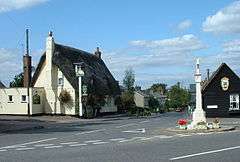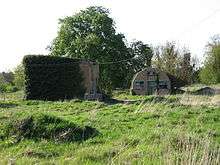Fowlmere
Fowlmere is one of the southernmost villages in Cambridgeshire, England. The population of the civil parish at the 2011 Census was 1,206.[1] It is very close to the Imperial War Museum Duxford, and 9 miles (14 km) southwest of the city of Cambridge.
| Fowlmere | |
|---|---|
 Pubs and war memorial in the centre of Fowlmere | |
 Fowlmere Location within Cambridgeshire | |
| Population | 1,206 (2011) |
| OS grid reference | TL427448 |
| Shire county | |
| Region | |
| Country | England |
| Sovereign state | United Kingdom |
| Post town | Royston |
| Postcode district | SG8 |
History
The village has an ancient landmark called the ‘Round Moat’, which is the remains of an early Saxon settlement dating from around the ninth century.[2]
Fowlmere is a parish, 6 miles (9.7 km) north-east from Royston, 2 1⁄2 miles (4.0 km) south-east from the Shepreth station on the Hitchin, Royston and Cambridge line of the London and North Eastern railway, and 9 miles (14 km) south from Cambridge, in the hundred of Thriplow, petty sessional division of Arrington and Melbourn, union and county court district of Royston, rural deanery of Barton, archdeaconry and diocese of Ely. The cemetery, on the Shepreth road, comprises 1-acre (4,000 m2) of ground, given by the late F. M. Beldam-Johns esq. and has a chapel, erected in 1912; it is under the control of the Parish Council.
— Kelly's Directory - Cambridgeshire - 1929
The Census Records from 1841–1891 can be found in the Cambridge Record Office. In addition the 1851 Census for Fowlmere is available in full transcript form, on microfiche, from the Cambridgeshire Family History Society Bookstall.
The church of St. Mary is a fine structure of flint in the Early English, Decorated and Perpendicular styles, consisting of chancel, nave, aisle, transepts, north porch and a lofty embattled central tower containing 5 bells; there are two memorial windows, and there is also a monument to the Mitchell family, dated 1745 and 1748: the church was restored during the period 1870-90, at a cost of about £3,000, and has 250 sittings. The register dates from the year 1561. The Congregational chapel was erected in 1780: in 1870 an apse was added and an organ purchased: the chapel underwent a thorough restoration in 1878, at a cost of about £1,100, this sum including the erection of a turret containing a clock and bell: there are 409 sittings. In the village is a cross of Portland stone, erected in 1919 as a memorial to the men of the parish who fell in the Great War, 1914-18.
— Kelly's Directory - Cambridgeshire - 1929
The village was struck by an F1/T2 tornado on 23 November 1981, as part of the record-breaking nationwide tornado outbreak on that day.[3]
Airfield

Fowlmere Airfield opened in late-1916 as an emergency landing ground for 75 (Home Defence) Squadron of the Royal Flying Corps, who had their HQ in Bedford and dispersed their three flights to Yelling (St Neots), Old Weston (Thrapston) and Therfield (Baldock) on anti-Zepplin duties. Its purpose was to receive aircraft lost, out of fuel or with engine troubles and was staffed with a minimum number of personnel whose prime task was to light flares to aid pilots in finding the site. It closed down after WW1.
As RAF Fowlmere, near the edge of the village, it was the location for the RAF Station and transferred to the United States Army Air Force (USAAF) for use by their 339th Fighter Group during World War II. The Group flew its first combat mission on 30 April 1944, and its last on 21 April 1945. Modern Air was established at the airfield during September 1990 by Derick Gunning and Anna McDowell. Now the airfield provides pilots with self-fly Piper aircraft and servicing, as well as PPL training.
- ICAO: EGMA
- Runway Length: 2,297 feet (700 m)
- Runway Surface: Grass
- Aircraft for hire (2009): 4
- PPR for visiting: 01763 208281
- Fowlmere radio: 135.7 MHz
Natural history
The Fowlmere nature reserve (maintained by the RSPB) is situated west of the village, between it and the village of Melbourn. With 2.4 kilometres (1 mi) of nature trails, it attracts many visitors. Several special birds are seen there, including: kingfishers, water rails, and grasshopper warblers.
Fowlmere, along with several other Cambridgeshire villages, lays claim to a sighting of the infamous Fen Tiger, a supposed wild big cat.[5]
See also
References
- "Civil Parish population 2011". Neighbourhood Statistics. Office for National Statistics. Retrieved 17 July 2016.
- Historic England. "Ringwork, known as `The Round Moat' (1014823)". National Heritage List for England. Retrieved 9 January 2014.
- http://www.eswd.eu/cgi-bin/eswd.cgi
- P Doyle files
- Cambridge Paranormal.
External links
| Wikimedia Commons has media related to Fowlmere. |